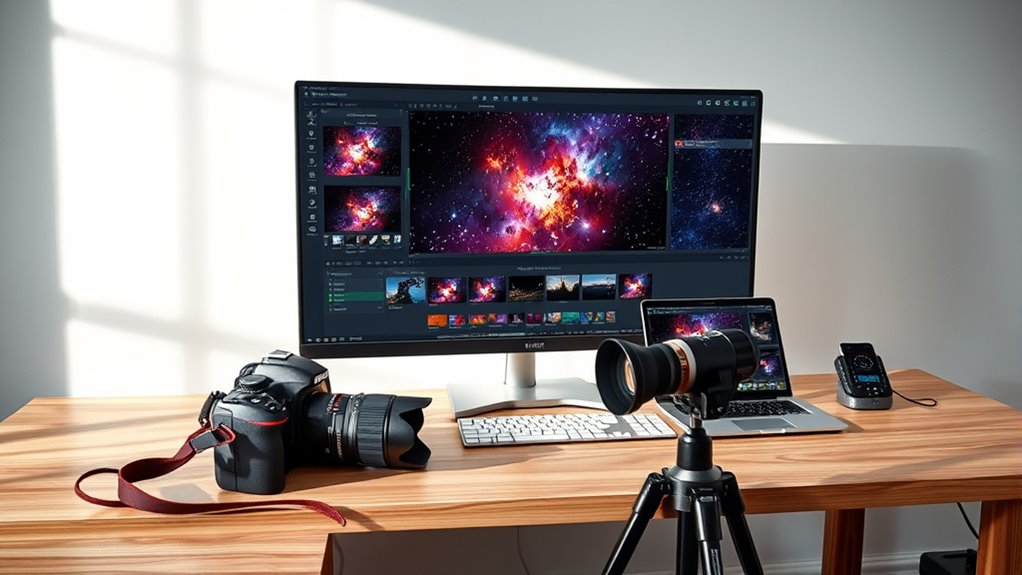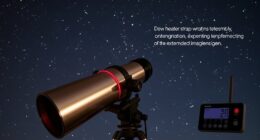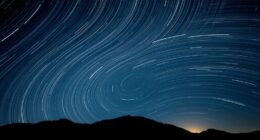To get started with DeepSkyStacker, gather your astrophotography images and calibration frames like bias, dark, and flat frames. Launch the software, load your images, and let it automatically align and stack them. Adjust the settings for noise reduction and star detection to improve results. The process is straightforward, and with some practice, you’ll produce clearer, more detailed images of deep sky objects. Keep exploring to master more advanced techniques and get the most out of your shots.
Key Takeaways
- Install DeepSkyStacker and gather your calibration frames (bias, dark, flat) for proper calibration.
- Load your light frames alongside calibration images in DeepSkyStacker.
- Use the calibration and alignment features to correct and align your images automatically.
- Choose stacking method (average or median) and adjust settings for noise reduction and star detection.
- Save the stacked image and perform post-processing adjustments like contrast and color enhancement.

If you’re new to astrophotography, deep sky stacking can seem intimidating at first. But once you understand the process, it becomes much more approachable. The key is mastering the fundamentals of image calibration and stacking techniques, which are essential for producing clear, detailed images of the night sky. DeepSkyStacker is a user-friendly software that simplifies these steps, making it easier for beginners to get started.
When you start with deep sky stacking, your first priority is to perform image calibration. This involves preparing your raw images by correcting for sensor noise, hot pixels, and other imperfections. You’ll need to create calibration frames—bias, dark, and flat frames—that help you remove these artifacts. Bias frames capture the camera’s read noise, dark frames record thermal noise, and flat frames correct for uneven field illumination. By calibrating your images, you guarantee that subsequent stacking results are accurate and free from unwanted noise, which is crucial for revealing faint celestial details.
Next, you’ll move on to stacking techniques. This process combines multiple exposures to enhance the signal-to-noise ratio, making faint objects more visible. DeepSkyStacker automates much of this, guiding you through aligning and stacking your images seamlessly. You start by loading your calibrated light frames into the program, then let it analyze and align them based on star positions. Proper alignment is essential because even slight shifts between frames can blur your final image. Once aligned, the software stacks the images by averaging or median combining them, which helps suppress noise and bring out subtle details in the nebulae, galaxies, or star clusters.
Throughout this process, you should pay attention to the quality of your frames. Discard any that are blurry or heavily affected by clouds or tracking errors, as including poor frames can diminish your final image quality. The stacking process in DeepSkyStacker is quite forgiving, allowing you to tweak settings like noise reduction, star detection, and image weighting to optimize results. As you become more comfortable, experimenting with different stacking techniques—such as averaging or median stacking—can help you find the best approach for your specific images.
Finally, after stacking, you’ll want to perform post-processing to enhance your image further. Adjusting contrast, brightness, and color balance can reveal even more intricate details of your astrophotography targets. DeepSkyStacker provides a solid foundation for stacking, but mastering these initial steps in calibration and techniques will give you a much better starting point. Additionally, understanding the patterns in angel numbers can inspire patience and persistence as you refine your skills. With practice, you’ll see how these processes transform your raw captures into stunning, detailed images of the cosmos.
Frequently Asked Questions
Can Deepskystacker Process Videos or Only Still Images?
DeepSkyStacker can only process still images, not videos. If you’re interested in video processing or live stacking, you’ll need different software designed for those tasks. DeepSkyStacker excels at stacking multiple astrophotos to improve detail and reduce noise, but it doesn’t support live stacking or real-time video processing. For videos, consider specialized tools like AstroVideo or Sharpcap, which are built for live stacking and video analysis.
Is Deepskystacker Compatible With Mac Operating Systems?
DeepSkyStacker isn’t natively compatible with Mac operating systems, as it’s primarily designed for Windows. However, you can use cross-platform support solutions like Wine or a virtual machine to run it on your Mac. These options allow you to utilize DeepSkyStacker effectively, but keep in mind that performance may vary. For seamless Mac compatibility, consider alternative astrophotography stacking software designed specifically for macOS.
How Do I Troubleshoot Alignment Errors During Stacking?
When alignment troubleshooting feels like trying to tame a wild beast, don’t panic! First, check your calibration frames—they’re often the culprit behind stacking errors. Guarantee your images are sharp and properly aligned before stacking. Use the “Re-Align” feature to correct minor issues, and verify your star detection settings. If errors persist, consider reducing noise and bright star interference, which can throw off alignment and cause major stacking mishaps.
Does Deepskystacker Support Batch Processing for Multiple Sessions?
Yes, DeepSkyStacker supports batch processing for multiple sessions. You can load several sets of images at once, allowing you to process multiple sessions efficiently. To do this, simply add all your image files to the program, then select the processing options you want. It automates stacking for each session, saving you time and effort, especially when working with large datasets or multiple nights of astrophotography.
Can I Integrate Deepskystacker With Other Astrophotography Software?
You can integrate DeepSkyStacker with other astrophotography software to improve your workflow automation. While it doesn’t have direct plugin support, you can streamline your process by using scripting or batch files to automate tasks like image calibration and stacking. Combining it with photo editing or telescope control software lets you create a more efficient, seamless workflow, saving you time and effort during your astrophotography sessions.
Conclusion
Just like a master painter gradually reveals a masterpiece, your patience and practice with DeepSkyStacker will uncover breathtaking cosmic wonders. Remember, every expert was once a beginner, gazing up at the stars with curiosity. Keep stacking, learning, and experimenting—soon you’ll find yourself capturing the universe’s secrets, much like a modern-day Galileo. Stay persistent, and the universe’s beauty will come into focus, one stacked image at a time.









